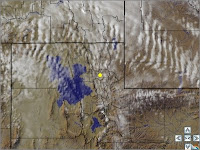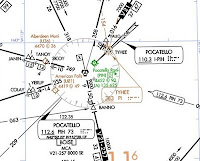
Spring Break has arrived, and let me tell you the faculty are as glad as the students!
Of course I flew yesterday, but not just boring holes in the sky. I got into our club Archer wearing a sport coat and nice slacks (but
no tie), and flew down to Provo, UT, where I spoke at a mathematics conference (the Intermountain Section of the Mathematical Association of America, to be precise).
I was speaking at 11:30 and figured on 1.5 for the flight (as opposed to 3.5 for the drive), but I wanted to hear some of the other speakers, too, so I was in the air early enough to see the sun rising over Malad, Idaho. Salt Lake's Class B was quiet, and I heard "Cleared into the Class B airspace" while still 50 DME from the I-BNT localizer (the center of the Class B).
Provo was busy with 2-seaters of various flavors doing touch-and-goes and a Citation that did a honking turn to "squeeze" into the pattern ahead of me. But the ground controller gave me a friendly "Taxi to the ramp via A, and welcome to Provo," and I got to park close to the FBO.
Provo always leaves a bad taste in my mouth from a King Air trip a few winters ago. The weather was bad, and I mean
bad: ILS minimums and surface temperature 0 Celsius. The passengers were late, and it snowed on the airplane while we were waiting. I had a new guy riding along for the experience, so we talked about the ground icing portion of the Operations Specifications (each carrier has individual rules issue by the FAA, called the Operations Specifications, or Op Specs).

The passengers showed up and we loaded them on. The deice truck came and sprayed us with hot alcohol. I started up, which is a complicated procedure in the King Air. A certain number of MASTER WARNINGs and MASTER CAUTIONs are normal, because the generators and inverters go online then offline then online, but this time there was an extra MASTER CAUTION for an EXT PWR light. That meant that we were plugged into the external power cart, through an access panel below the right wing outboard from the nacelle.
But of course there was nothing there. I tried recycling the battery bus, but the light stayed on. The only thing that I could think of was that the spray of the deicing fluid was shorting something in the access bay, so I shut down. It was cold and humid, the fog sticking to everything. Everything was orange in the glow of mercury vapor lights piercing the fog.
We got out and cleaned the deicing fluid out of the external power plug, blew on it a little to make sure it was dry. I felt the wing (dry) as I got in, and we started again. No light! We taxied to runway 18.
Snow was falling now, and as we took the runway I looked out onto the left wing. It was covered with snow, almost an inch worth. There is no way that we could take off like that, and I made the hard call: we're going back to get deiced again.
It made for a long night (I think we went to Fargo that night), and the company lost a bunch of money. In the morning I did the carpet dance for the Director of Operations (yes, I
had to get deiced twice). I pretended to be contrite but I knew that I had done the right thing.
(This is the same DO who got angry one summer when too many pilots were out of duty time. It seemed to me that when all of your pilots are out of duty them then the only proper response is "Thank you!")
But it was a beautiful day in Provo. The Wasatch Front is
right there when you're on the BYU campus (that's where the conference was held), and students were out running and sunning and enjoying spring. Of course there is no alcohol on the BYU campus, but better yet for me was that I needed no deicing alcohol to get home. (This time
I would have had to pay for it.)
The weather was gusty so there were more than a few bumps on the way home. The strong thermals and strong ridge lift got me thinking about flying gliders again, soon, but I flew the airplane I was in and held altitude. I landed at home with a 12 knot crosswind component, and went straight to the monthly EAA meeting.
I thought they would make fun of me for wearing a sport coat, but the only comment I heard was "Nice crosswind landing." They'd all stood on the ramp and watched...
Labels: Class B, Deicing, thermals









